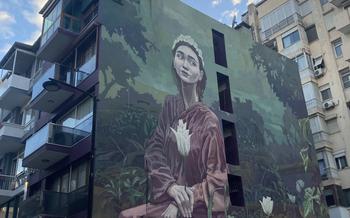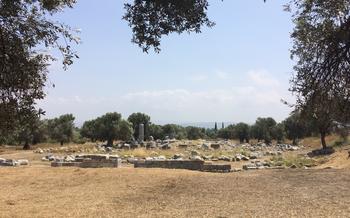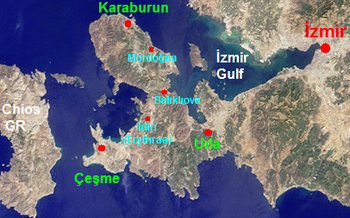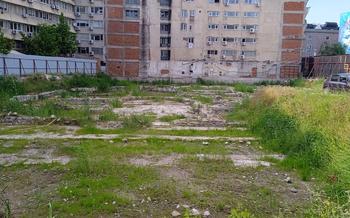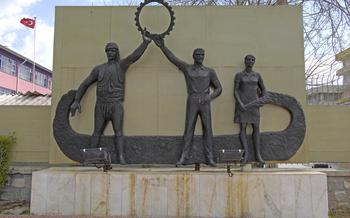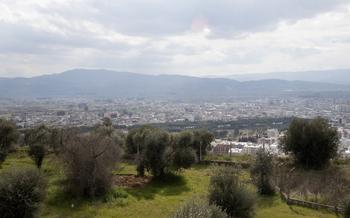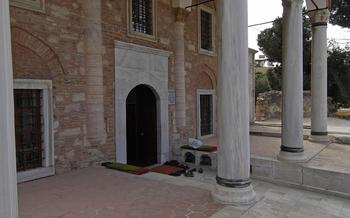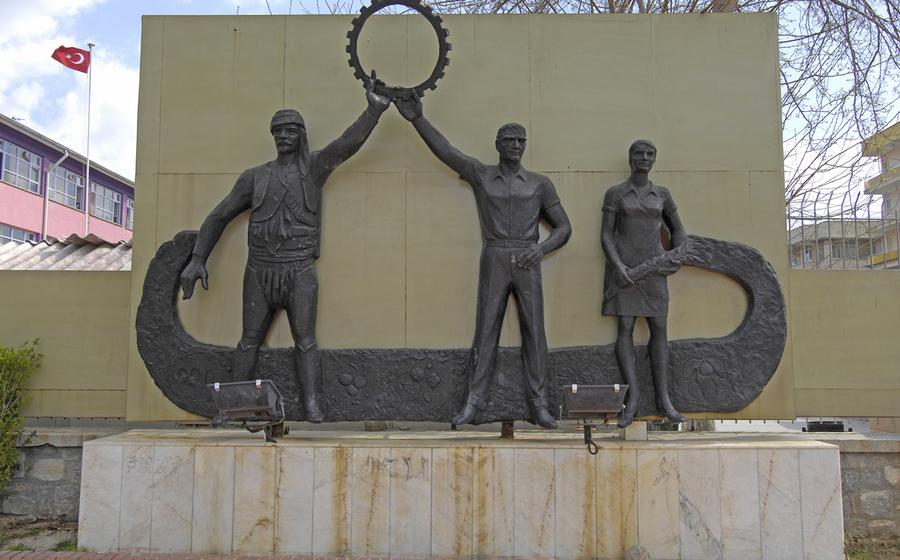
Panionion Ancient City
- A Journey Through Time: Exploring the Ruins
- The Sacred Sanctuary of Poseidon: A Divine Encounter
- Panionion's Panoramic Views: A Feast for the Eyes
- A Living Museum: History Comes Alive
- Unearthing the Secrets of Panionion: Archaeological Wonders
- The Ionian League: A Symbol of Unity
- Panionion's Connection to the Sea: A Maritime Legacy
- Panionion's Place in Ancient Greek Mythology: Legends and Lore
- Panionion's Contribution to Art and Architecture: Masterpieces in Stone
- A Day Trip from Aydın: Convenient and Accessible
- Panionion's Role in the Ancient World: A Center of Diplomacy
- Panionion's Legacy: A Bridge to the Past
- Insider Tip: Discover the Hidden Olive Groves
A Journey Through Time: Exploring the Ruins
Panionion's ruins are a gateway to the past, offering a glimpse into the lives and culture of ancient Ionians. Embark on a journey through time as you wander amidst the well-preserved city walls, which once protected Panionion from invaders. Admire the grandeur of the ancient temples and altars, where sacrifices were made to honor the gods. Explore the agora, the bustling marketplace where locals gathered to trade goods and socialize. Discover the residential districts, where ordinary people lived their daily lives. Each stone and structure tells a story, waiting to be uncovered.
The Sacred Sanctuary of Poseidon: A Divine Encounter
The sanctuary of Poseidon held immense religious significance in the ancient city of Panionion. Dedicated to the god of the sea, earthquakes, and storms, it was considered a sacred site where the Ionian League gathered to worship.
The sanctuary's architectural features reflected its importance. It boasted a grand temple, adorned with intricate carvings and sculptures depicting Poseidon's dominion over the sea. An altar stood prominently in front of the temple, serving as a place for offerings and sacrifices.
Religious ceremonies and rituals were a central part of life in Panionion. The annual festival of Poseidon was a grand event, attracting pilgrims from across the Ionian region. During the festival, processions, sacrifices, and prayers were offered to honor the god and seek his favor.
Archaeological discoveries in the sanctuary have shed light on the religious practices of the ancient Ionians. Votive offerings, such as inscribed tablets, statues, and pottery, have been unearthed, providing valuable insights into the beliefs and customs of the time.
Panionion's Panoramic Views: A Feast for the Eyes
Panionion offers breathtaking panoramic views that will leave you in awe. From the acropolis, you can feast your eyes on stunning vistas that stretch far and wide. The Aegean Sea shimmers in the distance, while the lush green valleys and rolling hills create a picturesque backdrop.
As the sun begins to set, the sky transforms into a canvas of vibrant colors, casting a golden glow over the ancient ruins. The coastal landscapes come alive with the twinkling lights of nearby villages, creating a magical atmosphere. Panionion is also an ideal spot for stargazing. On clear nights, the sky is adorned with a myriad of stars, offering a celestial spectacle that will take your breath away.
Whether you're a nature enthusiast, a photography buff, or simply someone who appreciates breathtaking views, Panionion has something to offer. Capture the beauty of this ancient city through your lens or simply soak in the tranquility and let the panoramic vistas transport you to another time.
A Living Museum: History Comes Alive
Panionion is not just a collection of ruins; it's a living museum where history comes alive. Interactive exhibits and displays bring the ancient city to life, allowing visitors to experience the sights, sounds, and smells of the past. Guided tours and storytelling sessions by knowledgeable guides provide a deeper understanding of the city's history, culture, and significance. Historical reenactments and performances transport visitors back in time, showcasing the daily lives, rituals, and celebrations of the ancient Greeks. Educational programs for all ages make learning about Panionion fun and engaging, ensuring that the city's legacy continues to inspire future generations.
Unearthing the Secrets of Panionion: Archaeological Wonders
Panionion has captivated the interest of archaeologists and historians worldwide, who have dedicated themselves to unearthing the secrets that lie beneath its ancient ruins. Through meticulous excavations and ongoing research, they have uncovered a wealth of artifacts and inscriptions that shed light on the city's rich past. These discoveries have provided valuable insights into the daily lives, customs, and beliefs of the ancient Ionians who once called Panionion home.
The archaeological excavations at Panionion have yielded an impressive collection of artifacts, including pottery shards, coins, tools, jewelry, and sculptures. These artifacts offer glimpses into the material culture and artistic traditions of the city's inhabitants. Inscriptions found at the site, such as dedicatory inscriptions and decrees, have provided crucial information about the city's political and religious practices.
One of the most significant archaeological discoveries at Panionion is the well-preserved theater. This impressive structure, capable of accommodating thousands of spectators, hosted theatrical performances, musical events, and religious ceremonies. The discovery of the theater highlights the importance of the arts and entertainment in ancient Ionian society.
The ongoing archaeological research at Panionion continues to contribute to our understanding of this ancient city. New discoveries are constantly being made, providing valuable insights into the history, culture, and significance of Panionion. These findings not only enrich our knowledge of the ancient world but also help us to better appreciate the enduring legacy of this remarkable city.
The Ionian League: A Symbol of Unity
The Ionian League was a remarkable alliance of twelve Ionian city-states that flourished in ancient times. It originated in the 6th century BC as a response to the growing power and influence of the Persian Empire. Panionion served as the central meeting place for the league, where representatives from each city-state gathered to discuss matters of common interest, forge alliances, and settle disputes. The league functioned as a symbol of unity and cooperation among the Ionians, allowing them to maintain their independence and cultural identity in the face of external threats.
The league's primary objective was to preserve the autonomy of its member cities and protect their shared interests. It provided a platform for political and cultural exchange, fostering a sense of unity and solidarity among the Ionians. The league also organized common religious festivals and rituals, which further strengthened the bonds between the member cities. These festivals celebrated the shared cultural heritage of the Ionians and reinforced their sense of belonging to a larger community.
The Ionian League served as a model for international cooperation and diplomacy in the ancient world. It demonstrated the power of unity and collaboration in confronting common challenges and achieving common goals. The league's legacy continues to inspire modern efforts to promote international cooperation, peace, and understanding.
Panionion's Connection to the Sea: A Maritime Legacy
Panionion's strategic location on the Aegean coast made it a crucial maritime hub in ancient times. The city's proximity to natural harbors and its easy access to major trade routes allowed it to flourish as a center of naval activities and commerce. The Ionian Greeks, known for their seafaring prowess, utilized Panionion as a base for their naval operations and trading expeditions.
The city's connection to the sea extended beyond trade and military endeavors. It also played a significant role in religious and cultural practices. The ancient Greeks revered Poseidon, the god of the sea, and Panionion was home to a sacred sanctuary dedicated to his worship. Sailors and fishermen would often visit the sanctuary to pray for safe voyages and bountiful catches.
Panionion's maritime legacy is further evidenced by the discovery of shipwrecks and ancient harbor structures in the vicinity of the city. These archaeological finds provide valuable insights into the shipbuilding techniques, maritime trade routes, and naval warfare practices of the ancient Ionians.
Today, visitors to Panionion can still sense the city's strong connection to the sea. The ruins of the ancient harbor, along with the stunning views of the Aegean Sea from the acropolis, offer a glimpse into the maritime world of ancient Greece.
Panionion's Place in Ancient Greek Mythology: Legends and Lore
Panionion, steeped in ancient Greek mythology, is a place where legends and lore intertwine with historical facts. According to myths, the city was founded by the legendary hero Ion, the son of Apollo and Creusa. Ion, guided by divine intervention, led a group of Ionian settlers to this land, establishing the city as a symbol of unity and shared heritage.
Panionion's sacred sanctuary of Poseidon was believed to be the site where the god of the sea emerged from the depths, striking the ground with his mighty trident, creating a spring of fresh water. This miraculous event, witnessed by the Ionians, solidified Poseidon's role as the city's divine protector.
Myths and legends surrounding Panionion often involve divine interventions and supernatural tales. Heroes, gods, and mythical creatures play significant roles in shaping the city's history and folklore. These stories have been passed down through generations, adding a layer of enchantment to the ancient ruins.
Panionion's oral traditions and storytelling customs keep these myths alive, ensuring that the city's rich cultural heritage continues to be celebrated and shared. Visitors can immerse themselves in these captivating tales, gaining a deeper understanding of the spiritual and mythical dimensions of this ancient Ionian city.
Panionion's Contribution to Art and Architecture: Masterpieces in Stone
The ancient city of Panionion was not only a political and religious center but also a hub of artistic and architectural innovation. The ruins that stand today showcase exquisite sculptures and reliefs, demonstrating the skill and creativity of the city's artisans. From intricate friezes depicting mythological scenes to finely carved statues of gods and heroes, Panionion's artistic legacy is a testament to the flourishing artistic traditions of the ancient world.
The architectural styles and techniques employed in Panionion's buildings further highlight the city's sophistication. The use of Ionic columns, intricate pediments, and symmetrical layouts reflects the influence of classical Greek architecture. Panionion's architects also incorporated local elements, creating a unique blend of styles that showcase the city's cultural identity.
The artistic and architectural achievements of Panionion were not isolated but rather part of a broader cultural exchange that took place throughout the ancient Greek world. Panionion's artists and architects interacted with their counterparts from other cities, sharing ideas and techniques that contributed to the development of a common artistic language. This exchange of ideas and influences resulted in a rich and diverse artistic heritage that continues to inspire and fascinate to this day.
A Day Trip from Aydın: Convenient and Accessible
Panionion Ancient City is conveniently located just 27 kilometers from Aydın, making it an ideal destination for a day trip or a weekend getaway. Reaching Panionion is effortless, as there are regular public transportation options available. Visitors can choose to take a bus or a taxi from Aydın, which takes approximately 30-45 minutes. Alternatively, renting a car offers the freedom to explore the area at your own pace and combine Panionion with other nearby attractions, such as the ancient city of Ephesus or the picturesque beaches of Kuşadası. Whether you prefer a guided tour or self-exploration, Panionion is easily accessible and promises a memorable travel experience.
Panionion's Role in the Ancient World: A Center of Diplomacy
Panionion's significance extended beyond religious and cultural realms, as it also played a crucial role in diplomacy and international relations. Representatives from various Ionian cities gathered at Panionion to discuss matters of common interest, resolve conflicts, and forge alliances. The city served as a neutral ground where disputes could be settled peacefully through negotiation and compromise.
As a center of diplomacy, Panionion facilitated the exchange of ideas, cultural practices, and political strategies among the Ionian cities. This exchange contributed to the development of a shared Ionian identity and strengthened the bonds of unity and cooperation among the member states.
Panionion's diplomatic role also extended beyond the Ionian League, as representatives from other Greek city-states and even foreign powers sometimes attended its meetings. This enabled Panionion to act as a bridge between different cultures and civilizations, promoting understanding and fostering peaceful relations.
The diplomatic legacy of Panionion serves as a reminder of the importance of dialogue, cooperation, and mutual respect in resolving conflicts and building lasting peace. The city's role as a center of diplomacy continues to inspire modern-day efforts to promote international understanding and cooperation.
Panionion's Legacy: A Bridge to the Past
Panionion's legacy extends far beyond its ancient walls. It has left an indelible mark on the course of history, influencing subsequent civilizations and cultures. The site's enduring significance lies in its role as a bridge to the past, connecting us with the wisdom and achievements of our ancestors.
The ruins of Panionion stand as a testament to the ingenuity and artistry of the ancient Greeks. They offer a glimpse into the social, political, and religious practices of a bygone era. The city's well-preserved structures, including temples, theaters, and public buildings, provide valuable insights into the daily lives of its inhabitants.
Protecting and preserving Panionion's heritage is of utmost importance. Ongoing conservation efforts aim to restore and maintain the site's integrity. Archaeological excavations continue to uncover new artifacts and shed light on the city's rich history. By preserving Panionion, we ensure that future generations can appreciate and learn from this remarkable ancient site.
Panionion's legacy lives on in the customs, traditions, and folklore of the region. The site's influence can be seen in the local architecture, cuisine, and storytelling traditions. By visiting Panionion, visitors can experience a tangible connection to the past and gain a deeper understanding of the region's cultural heritage.
Panionion's enduring legacy serves as a reminder of the importance of preserving and celebrating our shared history. It invites us to explore the roots of our civilizations and marvel at the achievements of those who came before us. As we walk among the ruins of Panionion, we are reminded that the past is not merely a collection of dates and events, but a vibrant and dynamic force that continues to shape our present and inspire our future.
Insider Tip: Discover the Hidden Olive Groves
Beyond the ancient ruins of Panionion, the surrounding countryside offers a hidden gem: lush olive groves that have been cultivated for centuries. Take a break from exploring the archaeological site and immerse yourself in the tranquility of these groves, where rows of gnarled olive trees stand as silent witnesses to the region's rich agricultural history.
Join local farmers during the harvest season to experience the traditional methods of olive picking and witness the transformation of these precious fruits into golden liquid gold. Learn about the meticulous care and expertise that goes into producing the region's renowned olive oil, a staple of Mediterranean cuisine.
Indulge in a taste of the local cuisine, where olive oil is not just a cooking ingredient but an integral part of the culinary experience. Sample freshly baked bread drizzled with aromatic olive oil, savor traditional dishes infused with its rich flavor, and discover the secrets behind the region's culinary delights.
This immersion into the world of olives offers a unique opportunity to connect with the local culture and traditions that have been shaped by this liquid gold for generations. It's an experience that perfectly complements the historical exploration of Panionion, creating a journey that engages all the senses and leaves a lasting impression.
